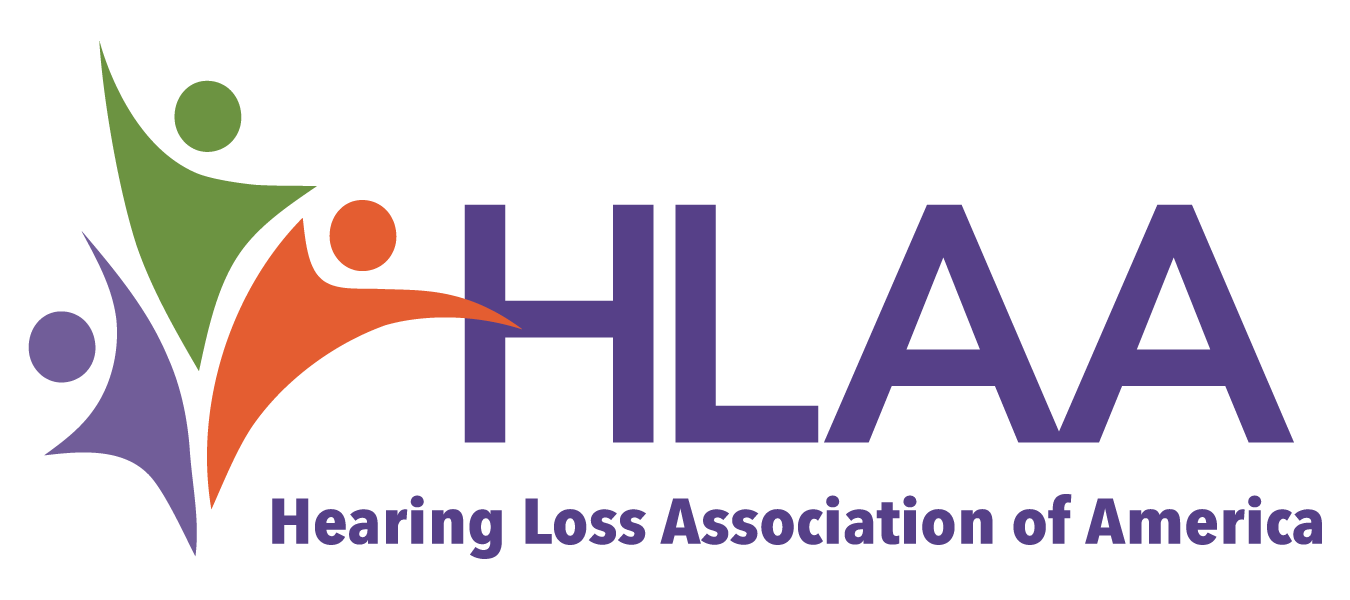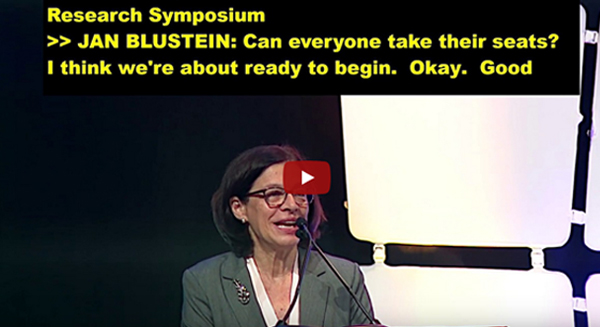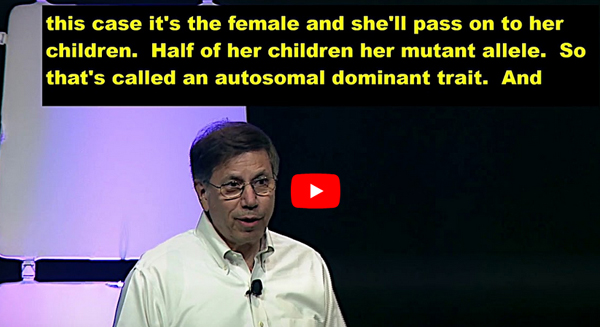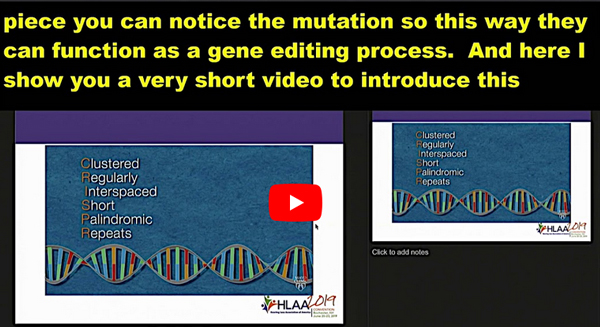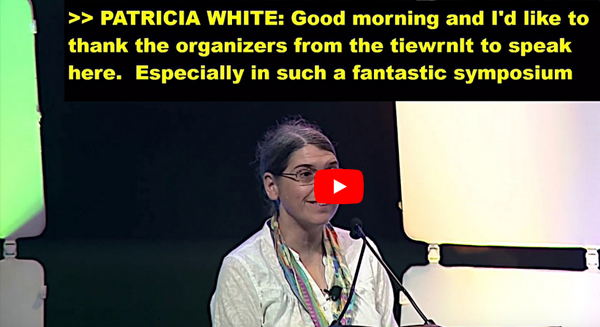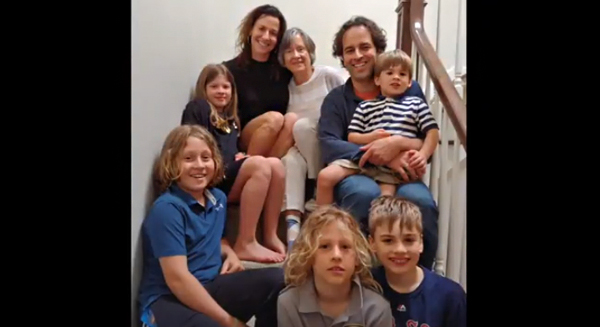
The following information is provided by world-renowned geneticists who presented at the HLAA2019 Research Symposium, The Latest on Genetics and Hearing Loss. They presented research on hearing loss that occurs during childhood or later in life and what can be done for families who have inherited the gene. The proceedings were videotaped and are captioned. Thank you to the following presenters: Hela Azaiez, Ph.D., Zheng-Yi Chen, Ph.D., Thomas Friedman, Ph.D., and Patricia M. White, Ph.D., who also provide answers to commonly-asked questions in the section after the videos.
The 2019 symposium was supported by a grant from the National Institute on Deafness and Other Communication Disorders, National Institutes of Health (Award Number R13DC017913). NIDCD has supported HLAA Research Symposia in prior years including one on genetics in 1999.
Welcome to the HLAA2019 Research Symposium
Jan Blustein, M.D., Ph.D. welcomes attendees and introduces Mia Visconti, director of consumer marketing at Cochlear Americas, sponsor.
Introduction to Genetics
Thomas Friedman, Ph.D., moderator, is chief of the Laboratory of Molecular Genetics, National Institute on Deafness and Other Communication Disorders, National Institutes of Health.
The Complexities of Genetic Hearing Loss
Hela Azaiez, Ph.D., is the research hearing team lead at the Molecular Otolaryngology and Renal Research Laboratories (MORL) at the University of Iowa.
From Mouse to Man
Zheng-Yi Chen, Ph.D., is principle investigator and associate professor of otolaryngology, Mass. Eye and Ear/Harvard Medical School.
Function: Can Supporting Cells Become Hair Cells?
Patricia M. White, Ph.D., is a research associate professor at the Ernest J. Del Monte Institute for Neuroscience, University of Rochester School of Medicine and Dentistry.
Genetic Hearing Loss: One Family’s Story
This video was produced for the workshop presented by Brenda Battat, held at the HLAA2019 Convention. In this film, we see two generations of hearing loss with James Battat (son) being interviewed as well as the Battat grandchildren from both of Brenda’s children.
Questions and Answers from the Researchers on Genetic Testing for Hearing Loss
What are hearing loss genes?
Genes are DNA sequences in our cells that carry the instructions to make proteins. Proteins, in turn, come in all types and varieties and play critical roles in the regulation, structure and function of our bodies. Changes in a DNA sequence can alter the associated protein, sometimes impairing its function. In the case of hearing loss, variations in a large number of different genes can lead to hearing loss by altering the ability of the inner ear to function properly. Genes associated with hearing loss are often called “hearing loss genes.” More than 100 genes are associated with hearing loss (see Hereditary Hearing Loss Homepage) and more “hearing loss genes” remain to be discovered.
Tell me more about gene variants that cause hearing loss.
Hearing loss genes are often subdivided into three categories: DFNA genes, DFNB genes and DFNX genes. These divisions reflect the type of inheritance. DFNA = dominant inheritance, DFNB = recessive inheritance and DFNX = X-linked inheritance. With DFNA genes, the deafness runs in families and is passed down from one generation to the next. Thus, a person can inherit a DNA change or variant from one parent and develop hearing loss. With DFNB genes, the deafness is rarely passed down from one generation to the next. Rather, a couple may have two, three or more children without hearing loss. In these cases, each offspring with hearing loss has to inherit a DNA change or variant from each parent to develop hearing loss. With DFNX genes, typically only males are at risk of hearing loss as the DNA variant is in a gene on the X-chromosome. Occasionally a fourth type of inheritance called mitochondrial inheritance (DFN-M) is seen.
How do variants in DFN genes cause hearing loss?
Often, we do not know precisely why or how a DNA variant causes hearing loss. We do know that protein function must be altered but the molecular details associated with the protein alteration may be very difficult to determine. By definition, all hearing loss genes are necessary for hearing, and so when they do not function properly, inner ear function and hearing are impacted.
If I have hearing loss, what do I gain from finding out about possible genetic causes?
Information about your genes may help you understand why you have hearing loss. If you know the exact genetic cause of your hearing loss, it is possible to compare you with all other people around the world with the same genetic cause of hearing loss. If you are 20 years old, and for example you want to know what your hearing loss will be like at the age of 40, we can look at the hearing thresholds in 40-year olds with the same genetic cause of hearing loss and reasonably expect your hearing to be similar. In addition, by knowing the genetic cause, we can determine whether there are other health care issues that warrant consideration. For example, some types of hearing loss are also associated with male infertility while other types of hearing loss are associated with female ovarian dysfunction. Another example would be Usher syndrome, which refers to the dual sensory impairments of hearing loss and vision loss. In all cases, the hearing loss precedes the vision loss and so determining whether or not a person has Usher syndrome is important both in planning for the future, in being proactive in order to delay the onset of vision loss, and in being positioned to participate in clinical trials for vision loss, some of which are ongoing. To date, there are no clinical trials using gene therapy for hearing loss.
Are there genealogy companies or research groups that can provide information to people like me about any genetic causes of my hearing loss?
Big commercial genealogy companies (such as Ancestry DNA, 23andMe, etc.). Look at broad sets of pre-defined DNA changes. Their approach is not useful for identifying the genetic cause of your hearing loss. Rather, you need to have your DNA analyzed using a special panel that contains all known hearing-loss genes. These types of panels have a success rate of nearly 50% of finding a genetic cause, when all comers are considered (i.e., everyone with hearing loss is tested). If these panels are unsuccessful, depending on your family history, you and your family may be eligible for research-based studies in which all of your genes (you have about 20,000 genes) are studied. As you might imagine, a study that looks at 20,000 genes can be long and complicated.
There are many testing laboratories that will perform clinical genetic testing for hearing loss, using the special panel. When selecting a laboratory, you need to take into consideration several aspects including their testing method. It should be comprehensive involving all known hearing loss genes, including detection and analysis of all kinds of genetic variations. It is also important that the testing lab holds both a long history of performing clinical diagnostics and a strong foundation in research as reflected by published scientific articles in leading journals in the field.
It is also important to consider how your results will be reported back to you and whether genetic counseling will be offered. Genetic counselors guide and support patients seeking more information about how inherited diseases and conditions might affect them or their families, and to interpret test results (see About Genetic Counselors, Find a Genetic Counselor).
We have listed the labs that offer comprehensive genetic testing for hearing loss and that satisfy all or some of the considerations mentioned above.
- Athena Diagnostics Inc.
- Blueprint Genetics
- Fulgent Genetics
- GeneDx
- Invitae
- Knight Molecular Diagnostic
- MORL (Molecular Otolaryngology and Renal Research Labs) at The University of Iowa
- Otogenetics
- Prevention Genetics
Do I need to pay to have genetic testing?
Generally, yes, although your health insurance may cover part or all of the cost.
What kind of therapies are available for hearing loss? What is on the horizon?
As a general rule, today there are no medicines that can be taken to treat genetic hearing loss. A notable exception is deafness associated with genetic changes in NLRP3. Variants in this gene can cause cochlear autoinflammation and nonsyndromic hearing loss DFNA34 that is responsive to anakinra therapy.
There are NO gene therapy treatments for hearing loss currently in clinical trials, however there are several companies working on gene therapy directed at specific types of genetic hearing loss. In the case of DFNB types of hearing loss, a normal copy gene has to be provided to compensate for lost function. This can be done by using a type of virus called AAV (adeno-associated virus) to carry a normal gene and deliver it into the inner ear[1].
There is also a new type of technology called CRISPR gene editing that can directly edit the DNA to either repair or disrupt mutations, and to restore functions. Because CRISPR works on DNA itself, its effects are permanent. A proof-of-concept study has shown that CRISPR can target a dominant (DFNA) type of hearing loss in a mouse model and rescue hearing[2]. In addition, small molecules are being studied for their effects in treating hearing loss[3], [4].
What more needs to be done to make gene therapy a reality?
A lot. Most studies on genetic hearing loss have been done in mice. Work in large animal models such as pigs is ongoing, but work in non-human primates is needed[5]. To conduct clinical trials, it is essential to know the “natural history” of each genetic type of hearing loss, i.e., the onset of hearing loss, the severity and the progression over time. These criteria will be used to select subjects for trials and to “predict” when and how much hearing recovery will occur.
What about hearing loss that does not have a genetic explanation?
Researchers are working on stimulating cochlear regeneration. Birds, for example, when deafened by an ototoxic drug regenerate lost cochlear hair cells[6], [7], and regain the ability to discriminate between different bird calls[8]. The new cochlear hair cells derive from adjacent cells within the cochlea called supporting cells[9]. Humans do not regenerate lost hair cells although we do not know precisely why. A specific type of signaling by a protein called ERBB2 is necessary for some aspects of regeneration in birds[10], [11]. Activating the same signaling molecule in the young mouse cochlea can cause new hair cells to form but much more work needs to be done to understand this process[12].
Besides being part of a genetic study, are there other ways that people can help or contribute?
There are other ways to contribute to research. You can agree to donate your temporal bones for analysis after you die. Researchers can then examine your cochlear histology, to determine what cells are still present and which cells have been lost. The National Temporal Bone Registry is at the Massachusetts Eye and Ear), and you can contact Nicole Pelletier or Garyfallia Pagonis.
Funding young investigators is critical if the progress being made today in developing therapies for hearing loss are carried on by the next generation of researchers. You can donate to nonprofit organizations that support young researchers in hearing science, such as the Hearing Health Foundation. Finally, you should call or email your representatives in Congress and let them know that you think increasing funding for medical research is important, because you have hearing loss and you want to support researchers working on cures.
[1] Akil O, Seal RP, Burke K, Wang C, Alemi A, During M, Edwards RH, Lustig LR. Restoration of hearing in the VGLUT3 knockout mouse using virally mediated gene therapy. Neuron. 2012;75(2):283-93. doi: 10.1016/j.neuron.2012.05.019. PubMed PMID: 22841313; PMCID: PMC3408581.
[2] Gao X, Tao Y, Lamas V, Huang M, Yeh WH, Pan B, Hu YJ, Hu JH, Thompson DB, Shu Y, Li Y, Wang H, Yang S, Xu Q, Polley DB, Liberman MC, Kong WJ, Holt JR, Chen ZY, Liu DR. Treatment of autosomal dominant hearing loss by in vivo delivery of genome editing agents. Nature. 2018;553(7687):217-21. doi: 10.1038/nature25164. PubMed PMID: 29258297; PMCID: PMC5784267.
[3] Nakano Y, Kelly MC, Rehman AU, Boger ET, Morell RJ, Kelley MW, Friedman TB, Banfi B. Defects in the Alternative Splicing-Dependent Regulation of REST Cause Deafness. Cell. 2018;174(3):536-48 e21. doi: 10.1016/j.cell.2018.06.004. PubMed PMID: 29961578; PMCID: PMC6370011.
[4] Gopal SR, Lee YT, Stepanyan R, McDermott BM, Jr., Alagramam KN. Unconventional secretory pathway activation restores hair cell mechanotransduction in an USH3A model. Proc Natl Acad Sci U S A. 2019;116(22):11000-9. doi: 10.1073/pnas.1817500116. PubMed PMID: 31097578; PMCID: PMC6561152.
[5] Hai T, Guo W, Yao J, Cao C, Luo A, Qi M, Wang X, Wang X, Huang J, Zhang Y, Zhang H, Wang D, Shang H, Hong Q, Zhang R, Jia Q, Zheng Q, Qin G, Li Y, Zhang T, Jin W, Chen ZY, Wang H, Zhou Q, Meng A, Wei H, Yang S, Zhao J. Creation of miniature pig model of human Waardenburg syndrome type 2A by ENU mutagenesis. Hum Genet. 2017;136(11-12):1463-75. doi: 10.1007/s00439-017-1851-2. PubMed PMID: 29094203.
[6] Corwin JT, Cotanche DA. Regeneration of sensory hair cells after acoustic trauma. Science. 1988;240(4860):1772-4. Epub 1988/06/24. PubMed PMID: 3381100.
[7] Ryals BM, Rubel EW. Hair cell regeneration after acoustic trauma in adult Coturnix quail. Science. 1988;240(4860):1774-6. Epub 1988/06/24. PubMed PMID: 3381101.
[8] Ryals BM, Dent ML, Dooling RJ. Return of function after hair cell regeneration. Hear Res. 2013;297:113-20. doi: 10.1016/j.heares.2012.11.019. PubMed PMID: 23202051; PMCID: PMC3593961.
[9] Stone JS, Leano SG, Baker LP, Rubel EW. Hair Cell Differentiation in Chick Cochlear Epithelium after Aminoglycoside Toxicity: In Vivo and In Vitro Observations J Neurosci. 1996;16:6157-74.
[10] Stankovic K, Rio C, Xia A, Sugawara M, Adams JC, Liberman MC, Corfas G. Survival of adult spiral ganglion neurons requires erbB receptor signaling in the inner ear. J Neurosci. 2004;24(40):8651-61. Epub 2004/10/08. doi: 24/40/8651 [pii] 10.1523/JNEUROSCI.0733-04.2004. PubMed PMID: 15470130.
[11] White PM, Stone JS, Groves AK, Segil N. EGFR signaling is required for regenerative proliferation in the cochlea: conservation in birds and mammals. Dev Biol. 2012;363(1):191-200. Epub 2012/01/11. doi: 10.1016/j.ydbio.2011.12.035. PubMed PMID: 22230616; PMCID: 3288574.
[12] Zhang J, Wang Q, Abdul-Aziz D, Mattiacio J, Edge AS, White PM. ERBB2 signaling drives supporting cell proliferation in vitro and apparent supernumerary hair cell formation in vivo in the neonatal mouse cochlea. Eur J Neurosci. 2018;48(10):3299. doi: 10.1111/ejn.14183.
